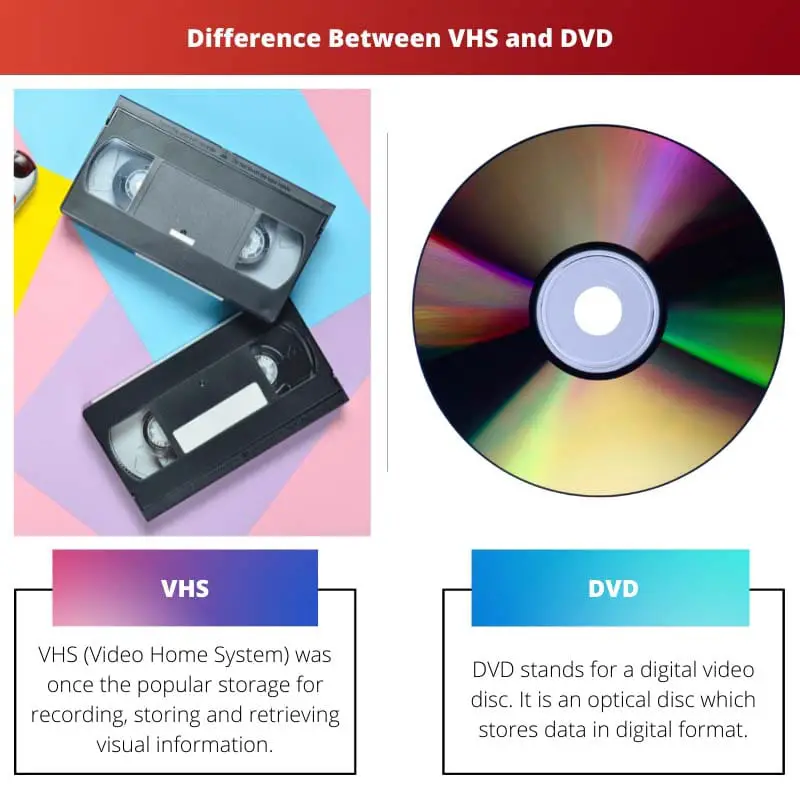Storing data was never easy until the invention of storage devices like floppy disks, hard drives etc. Earlier, people required piles of paper to record or store information. It was not only tedious but also time-consuming and occupied more space.
So, the requirement for a versatile compact device to store and retrieve information was induced. The need for storage devices strengthened when people started creating audio and video files.
The invention of magnetic tape and floppy disk paved the way for a revolution in storing data in digital format.
Key Takeaways
- VHS tapes are analog recordings, while DVDs are digital recordings. DVDs provide a superior picture and sound quality, while VHS tapes are susceptible to wear and tear, resulting in lower quality over time.
- DVDs are much smaller and more compact than VHS tapes, making them easier to store and transport. Additionally, DVDs offer added features such as scene selection, subtitles, and special features, which are unavailable on VHS tapes.
- VHS players are becoming increasingly difficult to find and maintain, and many people have transitioned to DVD players or digital streaming services. While some collectors still prefer VHS for nostalgic or sentimental reasons, DVDs are considered the more practical and convenient option for home entertainment.
VHS vs DVD
VHS (Video Home System) is an analog recording and playback system for video and audio using magnetic tape cassettes. DVD (Digital Versatile Disc) is a digital optical disc storage format that offers superior video and audio quality, increased durability, and interactive features.

VHS was one of the ancestors who pioneered media storage. It was used for storing video files on tape. VHS was touted as an advanced version of magnetic tapes when introduced in 1970.
A VHS recorder was needed to record or playback the audio or video data from VHS.
Despite limitations, it continued to rule the media industry for storing visual data till the introduction of CD and DVD, which turned out to be very disruptive. The introduction of the DVD was the beginning of the downfall of the VHS industry.
DVD is an optical disc which stores data in digital format. Storing and retrieving data from DVDs was very efficient and faster when compared to VHS. Moreover, the optical disc offered more storage space when compared to its predecessor.
Comparison Table
| Parameter of Comparison | VHS | DVD |
|---|---|---|
| Stands for | Video Home System. | Digital Video Disk. |
| Mode of Storage | Analog Format. | Digital Format. |
| Year of Invention | Invented in 1995 and was introduced in the market in the year 1996. | Invented in the year 1970 and was first introduced in the market in 1976. |
| Country of Origin | Japan | USA and Japan were responsible for DVD as a collaboration from industrial giants like Sony, Toshiba, and Time Warner Inc created it. |
| Storage Capacity | Maximum of two gigabytes of uncompressed data. | Minimum of 4.7 gigabytes of data on a single-sided DVD. |
| Weight | 212 grams. | 16 grams. |
| Physical Appearance | Rectangular. | Circular in shape. |
| Usage as of present | It has become obsolete. | It is still in use. |
What is VHS?
VHS (Video Home System) was once the popular storage for recording, storing and retrieving visual information. It stores data in its reel of magnetic tape. The data gets stored in the magnetic tape in the analog format.
The width of the tape would not exceed a half-inch. In the earlier stage, video cameras recorded the videos on VHS Tape. The data gets stored in the VHS format.
A video cassette recorder (VCR) was needed to playback the video. VCR had the dual capability of both recording and playing back video. The video player could only playback the video.
The way the data is played back from VHS tape is as follows. The VHS tape consists of a reel of magnetic tape. This tape is transferred from one reel to another when inserted into the player.
As the tape gets wounded to another reel, it passes over a playback head. This head is responsible for reading the signal and transforming the analogue signal back to a visual (audio or video) feed.
There are three modes in VHS tape. They are extended play(EP), standard play(SP) and long play (LP) modes. A maximum of 540 minutes long video can be recorded on a VHS when used in EP mode.
The introduction of VHC tape broke the monopoly of the television industry. People could record their desired program telecasted on television and view it later. This feature enabled VHS to gain market share when it was released.

What is DVD?
DVD stands for a digital video disc. It is an optical disc which stores data in digital format.
Though the DVD format and its existence got established only in 1995, the concept of optical discs started before the release of VHS in 1970.
The consumer-based optical disc was launched in the year 1978 by Laser Disc. The format did not gain acceptance and this search for a viable format led to the creation of the .vcd (Video CD) format.
In the same year, two other formats were created by the global giants in electronic space. The MMCD format, backed by Philips and Sony and SD (super density) disc by Toshiba and others, led to a confrontation in adopting a standard format.
Later, the pressure from the Technical working group (Apple, IBM, Sun Microsystems, Dell and other market leaders) brought a compromise between the two groups (MMCD and SD) and a new format called DVD got evolved.
The DVD had similarities to the super-density disc, except that DVD was a single-sided disc with dual-layer as an option. Thus, the single-sided DVD got a storage capacity of 4.7 GB and 8.5 GB storage capacity for a dual-sided disc.
DVD writer or burner drive is used to write data to the DVD. This drive is also responsible for reading data from the DVD. The data gets stored in the digital format (binary data of 1’s and 0’s).
There are numerous microscopic pits on the layer of the DVD in which the digital information gets encoded. The optical source from the DVD drive helps in retrieving or storing data.
Its efficiency in storing high-quality data leads to its boom in the market. Soon, DVD started penetrating all fields and ended VHS’s monopoly, making VHS tapes obsolete.

Main Differences Between VHS and DVD
- VHS tape stores data in analogue format, whereas DVD stores it in digital format.
- VHS stores data using magnetic tape, while the optical source is used in the case of DVD.
- DVD can store more data in high quality than a VHS tape which stores data in low quality. Moreover, VHS tapes tend to get damaged easily, but DVDs proved reliable as they were compact and slim.
- VHS tape cannot be relied on for long-time storage due to its analogue nature and many moving parts. DVD overcomes all the limitations of VHS tape.
- VHS tape and devices have been ruled out from the market, while DVDs still enjoy the lion’s share.

- https://www.econstor.eu/bitstream/10419/27761/1/605284490.PDF
- http://hsrc.himmelfarb.gwu.edu/cgi/viewcontent.cgi?article=1050&context=libfacpres

The impact of VHS and DVD in the media industry is well-articulated in this article, showcasing their respective contributions and limitations.
Agreed, the historical significance and transition from analog to digital storage are emphasized effectively.
The article effectively highlights the revolutionary impact of the transition from VHS to DVD, elucidating the relevance and advancements brought about by digital storage.
I couldn’t agree more. The discussion of VHS and DVD’s role in shaping media storage is both enlightening and compelling.
The comparison between VHS and DVD emphasizes the transformative technological shift that has reshaped data storage practices.
The transition from VHS to DVD was indeed a major milestone in data storage. The DVD’s digital format brought significant improvements in quality and convenience compared to VHS tapes.
Absolutely, the comparison between VHS and DVD clearly highlights the advancements offered by the digital format.
The comprehensive analysis of VHS and DVD’s functionality and limitations highlights the significant shift from analog to digital storage, showcasing the technological advancements in data storage.
Agreed, the article provides an insightful comparison between VHS and DVD, illustrating the paradigm shift in data storage technology effectively.
This article provided a comprehensive comparison on the evolution of data storage devices from VHS to DVD. It is interesting to learn about the history and technological advancements in data storage.
I agree, the historical context and technological details are well-explained.
The detailed explanation of VHS and DVD, along with their impact, makes for an insightful read. The differences in storage capacity, weight, and mode of storage are particularly fascinating.
I found the comparison table to be quite informative, capturing the core distinctions between VHS and DVD succinctly.
Agreed, the technical details and historical significance are well-presented throughout the article.
The intriguing insights into the evolution of data storage devices, from VHS to DVD, offer a compelling perspective on the revolutionary advancements that have shaped modern storage practices.
Absolutely, the article provides an engaging exploration of the transition from VHS to DVD, shedding light on the transformative impact of digital storage.
The article provides a valuable comparison between VHS and DVD, shedding light on their features, usage, and the eventual transition away from VHS tapes.
The comparison table provides a clear overview of the differences between VHS and DVD, making it easier to understand their respective attributes.
Indeed, the transition from VHS to DVD represented a significant shift in storage technology.
The article provides a meticulous comparison of VHS and DVD, presenting a nuanced understanding of their respective functionality and impact on the evolution of data storage.
The article effectively captures the revolutionary transition from VHS to DVD, shedding light on the transformative advancements in data storage.
Absolutely, the detailed breakdown of VHS and DVD’s features offers a comprehensive view of their significance in data storage.
The in-depth exploration of VHS and DVD, from their functionality to their role in media storage, offers a comprehensive understanding of these key storage devices.
Absolutely, the article provides a complete historical and technical overview of both VHS and DVD.